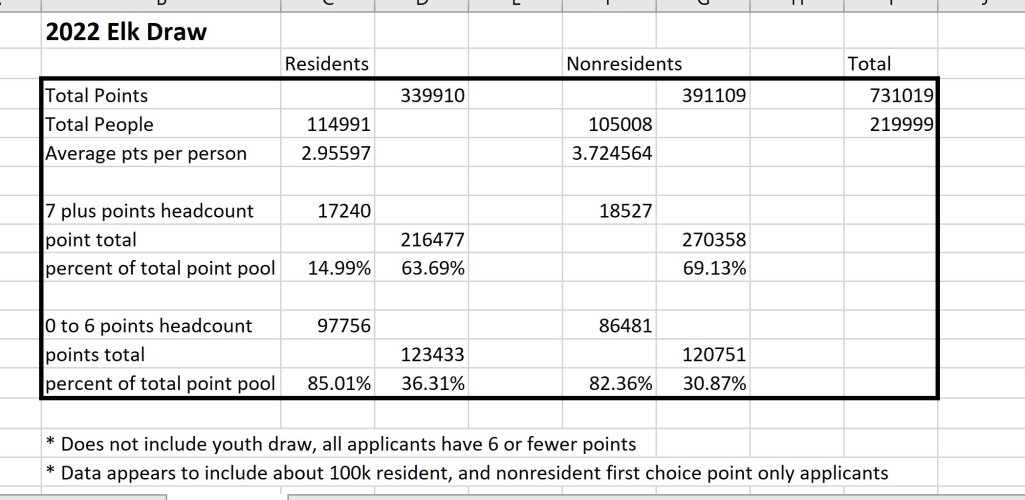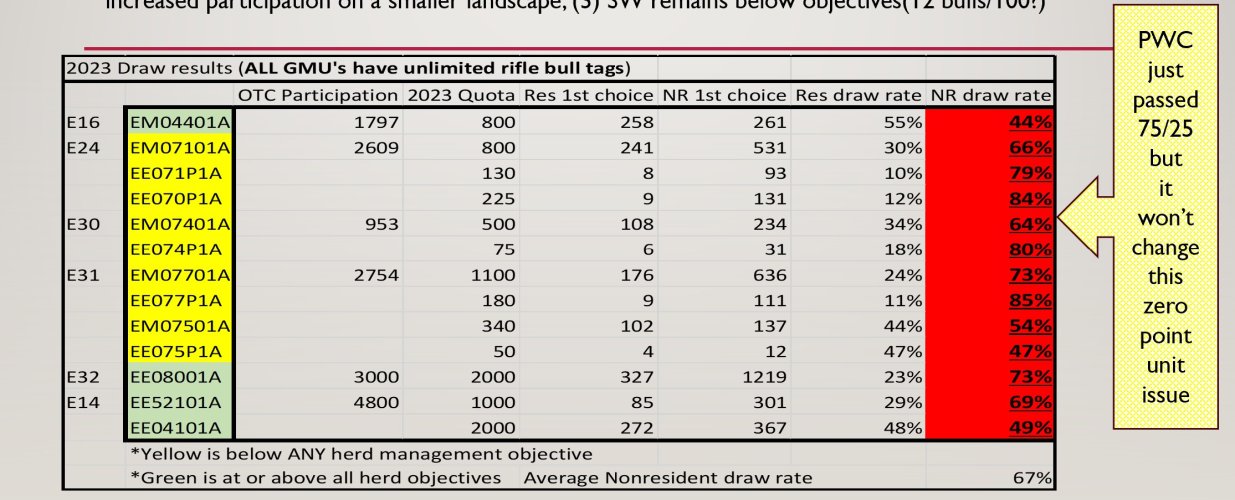grasshopper
Active member
- Joined
- Jun 28, 2010
- Messages
- 162
I need some help.
So for all you guys and gals headed to BGSS meetings and upcoming sportsmen's roundtables, I pulled the attached together. I've asked for 10 minutes to present at the NE region public roundtable in July, so far my request has been denied. I'm appealing. I thought the roundtable was exactly the forum for this discussion, maybe not. Please take it to yours. I've shared the same info on FB.
BGSS to some extent is about looking at what was done in the past and figuring out, (1) Did it accomplish what it was intended to do and (2) Do people like it. Last BGSS one of the biggest changes was the whole SW region was limited to just archers. Prior to BGSS archers lost OTC licenses in E-16, and that herd has rebounded very well according to CPW estimates after they eliminated cow tags . Archers also lost OTC in 80/81 which the herd is above objective. It is now drawn out at 73% nonresident. Recently archers lost OTC on the Grand Mesa while the herd is at objective of 15,500 elk. On the Grand Mesa going to draw took a supposed 2,000 resident bowhunter participation down to 800, a 60% decline. There are leftovers.
There was reasons for the limitations, some of them valid some of them bogus, IMO. Also, I understand the draw process well. Quotas are meant to be sold, allocations only apply to first choice. Leftovers go to anyone, but here is my take:
1. Most Residents have preference points and most are unwilling to spend them on a unit they have hunted as OTC. In unit 521, only 85(4.2%) of 2,000 residents turned into first choice applicants. In 41, 272(13.6%) of the 2,000 residents applied as a first choice hunt code. In unit 80/81 we had ~1,000 resident hunters turned into 327 first choice applicants. This hunt code sold out on 2nd choice with nonresidents receiving almost twice as many licenses as residents. 589 2nd choice residents applied as a second choice, only 133 drew.
In the SW EM077o1A hunt code nonresidents drew 73% of the licenses across 1st and 2nd choice, while 245 residents who applied did not draw.
So what is my point? On the table for this BGSS is limitations for more if not all units. What the learning should be in looking at the data is that OTC hunters have points. Points are are primary factor in application decision making. Residents are being disproportionately put at a disadvantage when OTC is taken to limited. An OTC unit converted to limited is worth zero points to most residents. If more units head to limited, perhaps the formula needs change to place more value on resident applicants.
I get complaints of crowding are ongoing. Everyone wants a healthy herd and a great hunt, including a sense of solitude. That said, Grand Mesa just saw a 60% decline in resident hunters while the elk herd is at objective. Why? Because people complained? Is there better options like capping nonresidents or a new allocation formula? Even looking at all hunters on the Mesa, supposedly we had close to 5,000 but only 1900 drew, and only 1025 applied ass 1st choice? They are killing resident participation.
Dan Prenzlow said when deer went totally limited we lost 80,000 hunters, and they never came back. Remember 2 directors back when CPW actually talked about recruitment, retention, etc? Now we talk about mutualism? What happened? Residents are being pushed out needlessly, maybe that is the plan.
If you are voting for total limitations, ask yourself why? Did moving from 3,000 to 2,000 in units 80/81 create solitude? Will there be any improvement in herd dynamics when the management plan says maximum opportunity, but the license scheme changes? The SW has been limited to archers for 3 or so years now, some of those DAU's still have 12-16 bulls per 100 cows, that's a shame.
Be careful what you vote for, you might get it, and it wasn't what you thought it would be.
If you have any feedback, iron sharpens iron, that's what I'm looking for. You might not agree, I'm ok with that.
So for all you guys and gals headed to BGSS meetings and upcoming sportsmen's roundtables, I pulled the attached together. I've asked for 10 minutes to present at the NE region public roundtable in July, so far my request has been denied. I'm appealing. I thought the roundtable was exactly the forum for this discussion, maybe not. Please take it to yours. I've shared the same info on FB.
BGSS to some extent is about looking at what was done in the past and figuring out, (1) Did it accomplish what it was intended to do and (2) Do people like it. Last BGSS one of the biggest changes was the whole SW region was limited to just archers. Prior to BGSS archers lost OTC licenses in E-16, and that herd has rebounded very well according to CPW estimates after they eliminated cow tags . Archers also lost OTC in 80/81 which the herd is above objective. It is now drawn out at 73% nonresident. Recently archers lost OTC on the Grand Mesa while the herd is at objective of 15,500 elk. On the Grand Mesa going to draw took a supposed 2,000 resident bowhunter participation down to 800, a 60% decline. There are leftovers.
There was reasons for the limitations, some of them valid some of them bogus, IMO. Also, I understand the draw process well. Quotas are meant to be sold, allocations only apply to first choice. Leftovers go to anyone, but here is my take:
1. Most Residents have preference points and most are unwilling to spend them on a unit they have hunted as OTC. In unit 521, only 85(4.2%) of 2,000 residents turned into first choice applicants. In 41, 272(13.6%) of the 2,000 residents applied as a first choice hunt code. In unit 80/81 we had ~1,000 resident hunters turned into 327 first choice applicants. This hunt code sold out on 2nd choice with nonresidents receiving almost twice as many licenses as residents. 589 2nd choice residents applied as a second choice, only 133 drew.
In the SW EM077o1A hunt code nonresidents drew 73% of the licenses across 1st and 2nd choice, while 245 residents who applied did not draw.
So what is my point? On the table for this BGSS is limitations for more if not all units. What the learning should be in looking at the data is that OTC hunters have points. Points are are primary factor in application decision making. Residents are being disproportionately put at a disadvantage when OTC is taken to limited. An OTC unit converted to limited is worth zero points to most residents. If more units head to limited, perhaps the formula needs change to place more value on resident applicants.
I get complaints of crowding are ongoing. Everyone wants a healthy herd and a great hunt, including a sense of solitude. That said, Grand Mesa just saw a 60% decline in resident hunters while the elk herd is at objective. Why? Because people complained? Is there better options like capping nonresidents or a new allocation formula? Even looking at all hunters on the Mesa, supposedly we had close to 5,000 but only 1900 drew, and only 1025 applied ass 1st choice? They are killing resident participation.
Dan Prenzlow said when deer went totally limited we lost 80,000 hunters, and they never came back. Remember 2 directors back when CPW actually talked about recruitment, retention, etc? Now we talk about mutualism? What happened? Residents are being pushed out needlessly, maybe that is the plan.
If you are voting for total limitations, ask yourself why? Did moving from 3,000 to 2,000 in units 80/81 create solitude? Will there be any improvement in herd dynamics when the management plan says maximum opportunity, but the license scheme changes? The SW has been limited to archers for 3 or so years now, some of those DAU's still have 12-16 bulls per 100 cows, that's a shame.
Be careful what you vote for, you might get it, and it wasn't what you thought it would be.
If you have any feedback, iron sharpens iron, that's what I'm looking for. You might not agree, I'm ok with that.







